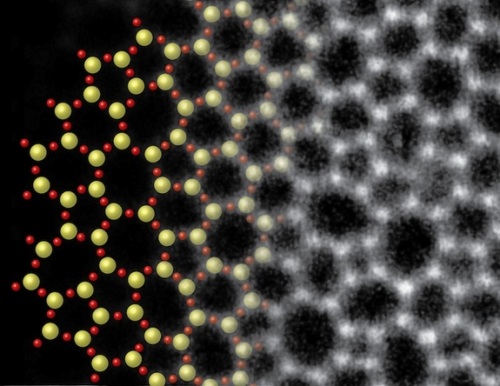Researchers at Cornell University and Germany’s University of Ulm have been formally recognized by the Guinness Book of World Records for creating the world’s thinnest sheet of glass, even though they never actually set out achieve this benchmark.

Microscopic photo of a sheet of glass only two atoms thick: it is blended with an artist's conception to show the structural rendering.
It all started when the group was creating graphene, a two-dimensional sheet of carbon atoms in a chicken wire crystal formation, on copper foils in a quartz furnace. When they went to inspect the material under an electron microscope, a bit of “muck” was noticed. Upon further inspection, the group found it to be composed of silicon and oxygen — the very elements found in everyday glass.
It is believed that an air leak during the manufacturing process caused the copper to react with the quartz, also made of silicon and oxygen. The interaction of the two materials resulted in a glass layer on what would have been an otherwise pure piece of graphene.
The glass is so impossibly thin (just two atoms thick as a matter of fact) that its individual silicon and oxygen atoms are visible via the microscope.
David A. Muller, professor of applied and engineering physics and director of the Kavli Institute at Cornell for Nanoscale Science, whose lab made the discovery, explained that beyond the sheer novelty of creating a material so thin, their work answers a decades-old question about the fundamental structure of glass. You see, scientists have always struggled to understand the material since it behaves like a solid but looks more like a liquid. Most solids when cooled arrange themselves into a rigid lattice. While glass is hard and has a solid appearance, the atoms that make up glass were believed to be arranged in a disordered network — kind of like a liquid.
Now, with this discovery, researchers have an exact picture of how the individual atoms that make up glass are arranged, and can confirm this theory.
What’s more, the structure itself is remarkably similar to a diagram drawn in 1932 by W.H. Zachariasen — a long-standing theoretical representation of how atoms are arranged in glass.
“This is the work that, when I look back at my career, I will be most proud of,” Muller said. “It’s the first time that anyone has been able to see the arrangement of atoms in a glass.”
The glass discovered by the Cornell / Ulm group could one day be used in nanotechnology and even in transistors, acting as a defect-free, ultra-thin material that improves the performance of various technologies, ranging from personal computers to smartphones and more.
The group’s work was originally published in the January 2012 issue of Nano Letters . The story has since grabbed headlines now that Guinness records officials took note. The achievement will be published in early September for inclusion in the 2014 book, and the breakthrough is featured in the publication’s 21st Century Science spread.
Story via: cornell.edu
Advertisement





